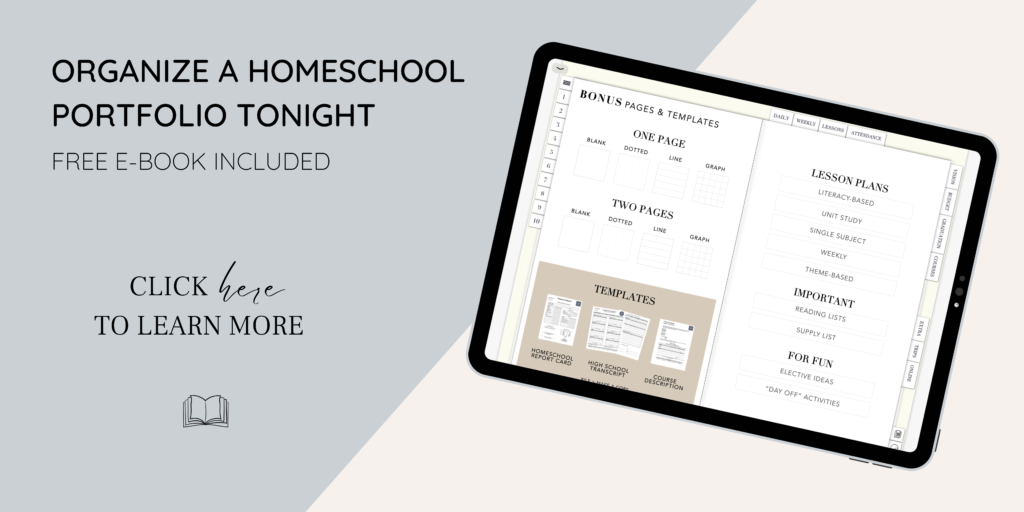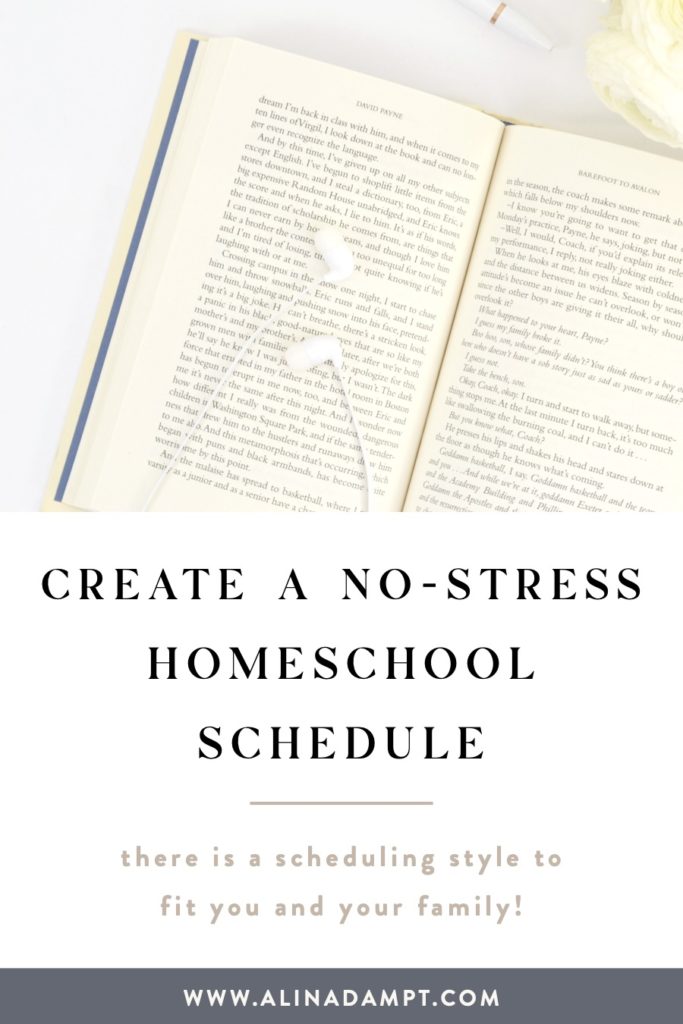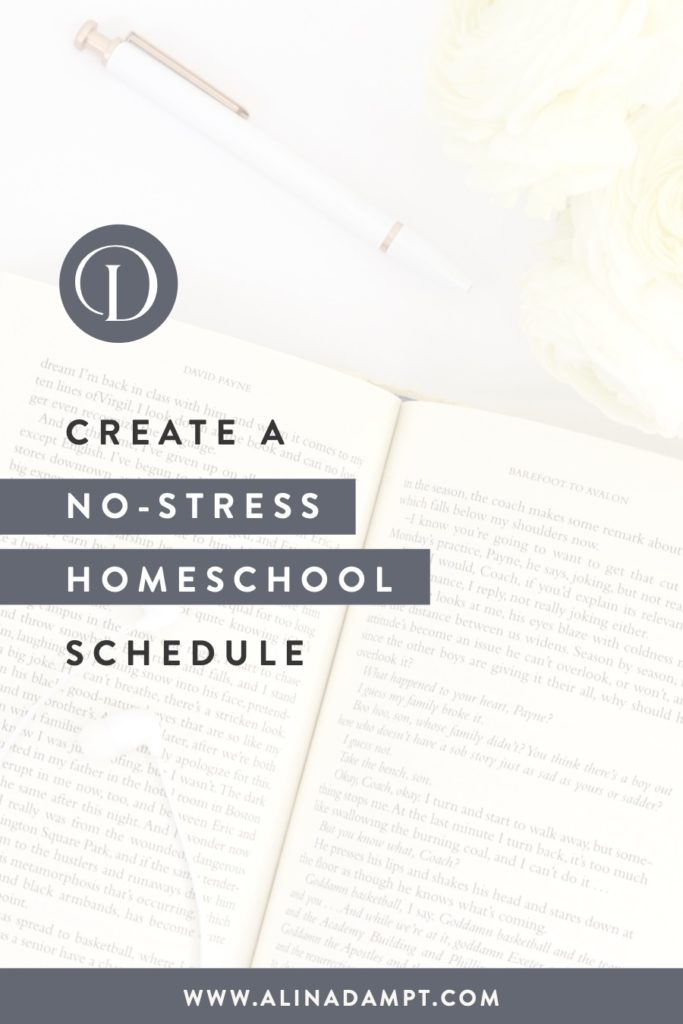The Store
digital planners and novels
find me elsewhere
Weekly Tutorials
straight to your inbox
Whether you're writing, digital planning, or just trying to manage motherhood, I'd love to be a part of your journey!
let's be pen pals!
Creating a No Stress Homeschool Schedule
18
Jun
Let’s face it, running a household, and especially running a homeschool can be overwhelming and we can often find ourselves spending too much time on some things, and not enough time on others. Managing our time is a lot more difficult when we don’t have public school parameters to work around or a full time job to schedule around. This is why a homeschool schedule is so necessary.
This is often one of the blessings (and curses) of public school and full-time jobs. You know there are certain things that have to get done before everyone leaves the house. The school decides your schedule. Then upon your return home you have specific chores/homework to finish, a dinner to make and eat, and your nighttime ritual.
Homeschooling can throw a family for a loop because suddenly you have to methodically plan out the whole day, and you have no boss or coworkers relying on you to follow through with the expectations. This, unfortunately, can make us homeschoolers lazy schedulers and planners. In some cases, that is a hidden talent for mothers: the ability to keep a schedule and stay reliable. For others it is more difficult.
No matter where you are on the spectrum, there is a scheduling style to fit you and your family! Today we’re going to discuss how you can set up a schedule for the year, what days you can take off, and how to treat “vacations.” We’ll also discuss differing weekly schedules and daily schedules so you can really delve into the details, and we’ll finish off with a discussion on different class structures.

Homeschool Schedule for the Year
There are a few different ways to decide how to fit in the required 180 days of school every year. For most states this is the minimal amount of school days you can have in a year. Some states don’t require you to submit any attendance, but others will. So it is good to be on top of it at the beginning of the year.
The most common form of scheduling for school is Traditional, which is your public school’s August to May schedule. This generally applies to public, charter, magnet, and private schools alike. The pros to this? Your kids will share their vacation time with their friends and neighbors. There is also a long summer break, if that is important to you. Cons? Well, this can be one of the biggest causes of burnout. You don’t really get a break from August all the way through May. That can be rough when you’re juggling school, household chores, and more at home. It is less flexible. If you want to take a vacation, everywhere is crowded because everyone else is on vacation too!
Your next option is Year-Round homeschooling. This means you do school year round, then take breaks when you need them. This can be great because you will always have a break around the corner and a light at the end of the tunnel when the going gets rough. Schooling is predictable, but flexible for when family emergencies come up. Unfortunately this scheduling means you will need to plan out your year more carefully and make sure you’re abiding by your state’s laws.
Calendar Scheduling is a common yearly schedule. This means you start your new work in January and finish this school year work by the end of the year (December.) This is a pretty interesting way of going about it because it means you are starting the year fresh. However, this does mean that if your child re-enters the school system or starts going to college, they will likely be starting in the middle of the year.
Sabbath schooling is not only named for religious people. This idea mirrors the idea of 6 days of work and rest on the 7th. It spreads out over the course of weeks. There are 6 weeks on, and 1 week off. Each term also can have different subjects, making deadlines very real to your kids. This is great because you have a regular break, and burnout is WAY less common. One difficulty is that you will have to regularly make plans for each learning period. Also, sometimes your breaks will not align with holidays.
Homeschool Schedule for the Week
Obviously, the first decisions you will have to make are on how many days during the week you will spend on “school.†Most common is a 5 days a week schedule with Monday-Friday being school days. This can cause burnout, but it is completely do-able.
The other option is 4 days a week. You could either cut off Friday and give yourself a longer weekend, or cut out a day in the middle of the week. This would give the kids a break, run errands, and recuperate.
I think it is important to note that there is no “one right way” to do this.

Homeschool Schedule for the Day
I’m going to make this clear from the beginning. You want to make a schedule that will encourage you to get up in the morning. Getting out of bed is the hardest part of the day. You need to make a personal plan that encourages rolling out of bed and starting your day right. If that means you are relying on that 6am shower to wake you up, then by all means do it. Are you hungry at first light? Make sure the kids know that breakfast is on the table from 8am-8:30am. If they miss it, they miss breakfast.
As a mom, and school teacher, your kids need to realize that the kitchen isn’t open 24/7 because you have other responsibilities. This also means that your children need to be on top of their own responsibilities. Do they need to have their bed made, hair brushed, and clothes changed? They need to know that. You could do this by making chore charts, or something similar.
Beyond this, as a parent you need to decide when and how the school day works. Which classes are required? How long do the kids spend on each class? Do they get breaks during the day? Are some activities off limits until their schoolwork is done? Kids need rules and guidelines.
You first option is the Finish When You Finish Method. What does this mean? Well, it means that your child has specific assignments for the day. Once they have finished their assignments they are free for the day. You can run into problems with this homeschool schedule where the kids will finish all of their work in one hour, then refuse to push themselves to learn more. Instead they will find an electronic device and play games the rest of the day, or find some other useless activity. Although there is this downside, it also encourages your child to get their work done and not sit around for any specific amount of time just staring at their work. They control how much time they spend in school, and good, completed work = freedom.
Your next option is The Schedule. This is the “school-at-home” method. Meaning you are taking the structured schedule of school and applying it to your home environment. This is great because it keeps an organized home environment. However, children tend to get bored with their work as they watch the clock tick. You could set subjects in a specific order, or just set 30 or 45 minute increments of time and let your children check off their subjects in the order they’d like.
School at Night is useful for families with weird work schedules for the parent. Is dad at home in the morning? Maybe you’d like some family time for breakfast, and then you let your kids play and wear themselves out so they are ready to sit and work in the later afternoon. Sometimes it is simply better for your kids to be working when dad comes home so he can help with any subjects he has as strengths.
Lastly, the School at Some Point method that encourages your children to learn when they are ready. This is common in unschooling. You base learning off of a child’s interests or questions; otherwise known as child-led learning.
Organizing Classes to Fit Your Methods
There are a few ways to organize your classes. First, consider how classes are organized in school. This is called Block Scheduling. This means that you have a specific period of time that is designated to learning specific material, such as a semester or a quarter. This is great for teaching your children how deadlines work.
Your next option is a Loop Schedule. Create a list of required classes. You will make a list of assignments and they take the time they need to finish off their work and simply pick up where they left off.

Conclusion
Your homeschool schedule needs to be personalized to you! Homeschooling is all about getting complete control of your life, and not having to follow someone else’s schedule (in this case, public schools.) Your family’s needs for scheduling and homeschooling in general will 100% differ from pretty much every other homeschooling family, and THAT IS OKAY. In fact, that is good because it means that you are homeschooling for your child’s good instead of doing it because that is how society does it.
Use my free homeschooling downloads to plan your own schedule!
How do you hope to schedule your homeschooling?


Leave a Reply Cancel reply
@alinadampt
planning, writing, and real life
get the freebie
2024 Digital Planner
A Goodnotes Digital Planner to get you started on your 2024 journey.